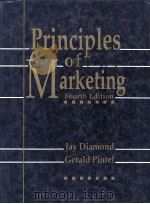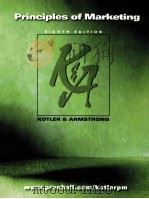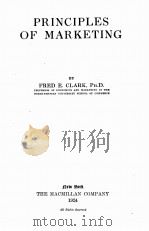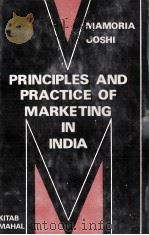《Principles of marketing》
| 作者 | Philip Kotler 编者 |
|---|---|
| 出版 | Prentice Hall |
| 参考页数 | 794 |
| 出版时间 | 1996(求助前请核对) 目录预览 |
| ISBN号 | 无 — 求助条款 |
| PDF编号 | 818987368(仅供预览,未存储实际文件) |
| 求助格式 | 扫描PDF(若分多册发行,每次仅能受理1册) |

PART Ⅰ UNDERSTANDING MARKETING AND THE MARKETING PROCESS2
1 Marketing in a Changing World: Creating Customer Value and Satisfaction2
What Is Marketing?6
Needs, Wants, and Demands7
Products9
Value, Satisfaction, and Quality10
Exchange, Transactions, and Relationships11
Markets12
Marketing13
Marketing Management14
Demand Management14
Building Profitable Customer Relationships14
Marketing Management Philosophies15
The Production Concept15
The Product Concept17
The Selling Concept17
The Marketing Concept19
The Societal Marketing Concept20
Marketing Challenges into the Next Century22
Growth of Non-Profit Marketing22
Rapid Globalization23
The Changing World Economy25
The Call for More Ethics and Social Responsibility26
The New Marketing Landscape26
Summary27
Key Terms28
Discussing the Issues28
Applying the Concepts29
References29
COMPANY CASE 1: DOORGUARD: TRYING TO MAKE A DENT IN THE MARKET30
VIDEO CASE 1: ZELLERS STRIKES BACK33
2 Strategic Planning and the Marketing Process34
Strategic Planning37
Defining the Company Mission38
Setting Company Objectives and Goals40
Designing the Business Portfolio41
Analysing the Current Business Portfolio41
Developing Growth Strategies44
Planning Functional Strategies45
The Marketing Process47
Target Consumers47
Marketing Strategies for Competitive Advantage50
Developing the Marketing Mix51
Managing the Marketing Effort53
Marketing Analysis54
Marketing Planning54
Marketing Implementation57
Marketing Department Organization60
Marketing Control62
The Marketing Environment64
Summary65
Key Terms66
Discussing the Issues66
Applying the Concepts66
References67
COMPANY CASE 2: TRAP-EASE: THE BIG CHEESE OF MOUSETRAPS68
VIDEO CASE 2: TAKING A RISK OR PLAYING IT SAFE70
3 The Marketing Environment72
The Company's Microenvironment76
The Company76
Suppliers76
Marketing Intermediaries76
Customers77
Competitors77
Publics77
The Company's Macroenvironment78
Demographic Environment78
Economic Environment86
Natural Environment88
Technological Environment90
Political Environment92
Cultural Environment94
Responding to the Marketing Environment98
Summary100
Key Terms100
Discussing the Issues101
Applying the Concepts101
References102
Demographic Study: Fifty something: Don't Call Me Old103
VIDEO CASE 3: MAIL-ORDER PHARMACY105
COMPREHENSIVE CASE I: MASTERCARD: CHARGING THE COMPETITION106
PART Ⅱ ANALYSING MARKET OPPORTUNITIES110
4 Marketing Research and Information Systems110
The Marketing Information System114
Assessing Information Needs114
Developing Information115
Distributing Information120
The Marketing Research Process121
Defining the Problem and Research Objectives121
Developing the Research Plan123
Implementing the Research Plan134
Interpreting and Reporting the Findings135
Other Marketing Research Considerations135
Summary140
Key Terms140
Discussing the Issues140
Applying the Concepts141
References141
COMPANY CASE 4: ACT Ⅰ:FEELING OUT THE APPLIANCE CONTROLS MARKET143
VIDEO CASE 4: TOUGH TO REACH147
5 Consumer Markets and Consumer Buyer Behaviour148
Model of Consumer Behaviour151
Characteristics Affecting Consumer Behaviour152
Cultural Factors152
Social Factors158
Personal Factors159
Psychological Factors163
Consumer Buying Roles169
Types of Buying Decision Behaviour169
Complex Buying Behaviour169
Dissonance-Reducing Buying Behaviour170
Habitual Buying Behaviour170
Variety-Seeking Buying Behaviour171
The Buyer Decision Process171
Need Recognition172
Information Search172
Evaluation of Alternatives173
Purchase Decision174
Postpurchase Behaviour174
The Buyer Decision Process for New Products175
Stages in the Adoption Process176
Individual Differences in Innovativeness177
Influence of Product Characteristics on Rate of Adoption178
Consumer Behaviour Across International Borders179
Summary181
Key Terms182
Discussing the Issues182
Applying the Concepts182
References183
COMPANY CASE 5: SHISEIDO: RETHINKING THE FUTURE184
VIDEO CASE 5: RETURN OF A STATUS SYMBOL186
COMPREHENSIVE CASE Ⅱ: PLEDGE: ASSESSING MARKETING STRATEGIES187
6 Business Markets and Business Buyer Behaviour198
Business Markets201
Characteristics of Business Markets201
A Model of Business Buyer Behaviour206
Business Buyer Behaviour206
Major Types of Buying Situations206
Participants in the Business Buying Process208
Major Influences on Business Buyers208
The Business Buying Process214
Institutional and Government Markets217
Institutional Markets217
Government Markets217
Summary220
Key Terms220
Discussing the Issues220
Applying the Concepts221
References221
COMPANY CASE 6: ACT Ⅱ CONTROLLING AN INDUSTRIAL MARKET222
PART Ⅲ SELECTING TARGET MARKETS228
7 Measuring and Forecasting Demand228
Defining the Market231
Measuring Current Market Demand231
Estimating Total Market Demand232
Estimating Area Market Demand234
Estimating Actual Sales and Market Shares236
Forecasting Future Demand236
Survey of Buyers' Intentions237
Composite of Sales Force Opinions239
Expert Opinion240
Test Marketing241
Time-Series Analysis241
Leading Indicators241
Statistical Demand Analysis242
Summary242
Key Terms243
Discussing the Issues243
Applying the Concepts244
References244
COMPANY CASE 7: FORECASTING CHILD'S PLAY245
VIDEO CASE 7: WHAT'S OUR MARKET SHARE?247
8 Market Segmentation, Targeting, and Positioning for Competitive Advantage248
Markets250
Market Segmentation252
Bases for Segmenting Consumer Markets253
Segmenting Business Markets261
Segmenting International Markets263
Requirements for Effective Segmentation264
Market Targeting265
Evaluating Market Segments265
Selecting Market Segments266
Positioning for Competitive Advantage271
What Is Market Positioning?271
Positioning Strategies271
Choosing and Implementing a Positioning Strategy272
Summary279
Key Terms280
Discussing the Issues280
Applying the Concepts280
References281
COMPANY CASE 8A: QUAKER OATS: DOUSING ON THE COMPETITION281
COMPANY CASE 8B: RYKA: BE STRONG284
VIDEO CASE 8: PASTA: CONDITIONING FOR THE U.S. MARKET286
PART Ⅳ DEVELOPING THE MARKETING MIX288
9 Designing Products: Products, Brands, Packaging, and Services288
What Is a Product?290
Product Classifications292
Consumer Products292
Industrial Products293
Individual Product Decisions294
Product Attributes294
Branding298
Marketers Speak Out305
Packaging311
Labelling314
Product-Support Services315
Product Line Decisions316
Product Line Length316
Product Line Modernization318
Product Line Featuring318
Product Mix Decisions319
International Product Decisions320
Summary322
Key Terms323
Discussing the Issues323
Applying the Concepts324
References324
COMPANY CASE 9: COLGATE: SQUEEZING MORE FROM A BRAND NAME326
VIDEO CASE 9: CREATING BREAD: THE STAPLE OF LIFE328
10 Designing Products: New-Product Development and Product Life-Cycle Strategies330
New-Product Development Strategy333
New-Product Success and Failure333
The New-Product Dilemma334
The New-Product Development Process336
Idea Generation336
Idea Screening337
Concept Development and Testing338
Marketing Strategy Development340
Business Analysis341
Product Development341
Test Marketing342
Commercialization344
Marketers Speak Out345
Speeding Up New-Product Development346
Product Life-Cycle Strategies347
Introduction Stage349
Growth Stage350
Maturity Stage350
Decline Stage353
Summary354
Key Terms355
Discussing the Issues355
Applying the Concepts356
References356
COMPANY CASE 10: INTRODUCING SPLENDA BRAND SWEETENER357
VIDEO CASE 10: THE FRIDGE359
11 Pricing Products: Pricing Considerations and Approaches360
Factors to Consider When Setting Prices363
Internal Factors Affecting Pricing Decisions364
External Factors Affecting Pricing Decisions369
General Pricing Approaches374
Cost-Based Pricing376
Value-Based Pricing377
Competition-Based Pricing379
Summary380
Key Terms381
Discussing the Issues381
Applying the Concepts381
References382
COMPANY CASE 11: CANADIAN VS. AIR CANADA: SURVIVING THE FARE WARS382
VIDEO CASE 11: UNITEL385
12 Pricing Products: Pricing Strategies386
New-Product Pricing Strategies389
Market-Skimming Pricing389
Market-Penetration Pricing390
Product-Mix Pricing Strategies391
Product Line Pricing391
Optional-Product Pricing392
Captive-Product Pricing392
By-Product Pricing392
Product-Bundle Pricing393
Price-Adjustment Strategies393
Discount and Allowance Pricing393
Segmented Pricing394
Psychological Pricing395
Promotional Pricing396
Value Pricing397
Geographical Pricing397
International Pricing400
Price Changes401
Initiating Price Changes401
Responding to Price Changes403
Summary406
Key Terms406
Discussing the Issues407
Applying the Concepts407
References407
COMPANY CASE 12: CIRCUITCITY: SELLING USED CARS LIKE STEREOS408
VIDEO CASE 12: WEDDING BELLS410
13 Placing Products: Distribution Channels and Logistics Management412
The Nature of Distribution Channels416
Why Are Marketing Intermediaries Used?416
Distribution Channel Functions416
Number of Channel Levels417
Channels in the Service Sector419
Channel Behaviour and Organization419
Channel Behaviour420
Vertical Marketing Systems422
Horizontal Marketing Systems425
Hybrid Marketing Systems426
Channel Design Decisions427
Analysing Consumer Service Needs428
Setting the Channel Objectives and Constraints429
Identifying Major Alternatives430
Evaluating the Major Alternatives432
Designing International Distribution Channels433
Channel Management Decisions434
Selecting Channel Members434
Motivating Channel Members434
Evaluating Channel Members435
Physical Distribution and Logistics Management437
Nature and Importance of Physical Distribution and Marketing Logistics437
Goals of the Logistics System438
Major Logistics Functions439
Integrated Logistics Management443
Summary445
Key Terms446
Discussing the Issues446
Applying the Concepts447
References447
COMPANY CASE 13: ICON ACOUSTICS: BYPASSING TRADITION448
VIDEO CASE 13: THE CHANNEL NOT TAKEN451
14 Placing Products: Retailing and Wholesaling452
Retailing454
Store Retailing455
Amount of Service455
Product Line455
Relative Prices460
Control of Outlets462
Type of Store Cluster463
Non-Store Retailing464
Direct Marketing464
Direct Selling465
Automatic Vending467
Retailer Marketing Decisions468
Target Market and Positioning Decision468
Product Assortment and Services Decision468
Price Decision472
Promotion Decision472
Place Decision472
The Future of Retailing472
Wholesaling473
Types of Wholesalers474
Merchant Wholesalers474
Brokers and Agents476
Manufacturers' Sales Branches and Offices477
Wholesaler Marketing Decisions477
Target Market and Positioning Decision477
Marketing Mix Decisions477
Trends in Wholesaling478
Summary479
Key Terms480
Discussing the Issues480
Applying the Concepts481
References481
COMPANY CASE 14: CANADIAN RETAILING; AN INDUSTRY IN CHAOS482
VIDEO CASE 14: BACK TO SQUARE ONE486
15 Promoting Products: Marketing Communication Strategy488
Steps in Developing Effective Communication492
Identifying the Target Audience493
Determining the Response Sought493
Marketers Speak Out494
Choosing a Message495
Choosing Media497
Selecting the Message Source498
Collecting Feedback499
Setting the Total Promotion Budget and Mix500
Setting the Total Promotion Budget500
Setting the Promotion Mix501
The Changing Face of Marketing Communications505
The Changing Communication Environment506
Growth of Direct Marketing507
Integrated Marketing Communications511
Socially Responsible Marketing Communication512
Advertising512
Personal Selling514
Direct Marketing515
Summary516
Key Terms517
Discussing the Issues518
Applying the Concepts518
References519
COMPANY CASE 15: AVON: A PROMOTIONAL STRATEGY MAKEOVER520
VIDEO CASE 15: DIRECT RESPONSE-IMMEDIATE RESULTS523
Window on the Future: Internet Marketing524
The Explosive Growth of "The Web"525
A Brief History of the Internet525
The World Wide Web: An Evolving Marketing Tool525
Understanding Empowered Consumers526
Who Uses the Net527
Using the Internet for Competitive Advantage527
Enhancing Strategic Positioning527
Creation of First-Mover Advantages529
A New Focus for Marketing Strategy529
The Need for Careful Segmentation530
The Internet and Marketing Mix Decisions531
Improved Product Decisions531
Revised Channels of Distribution532
Pricing and Payment532
Communication Vehicle533
Promotion Vehicle533
Monitoring Effectiveness534
The Future of Internet Marketing535
Facilitators Who Support Internet Marketing535
Interesting and Effective Web Sites536
References538
CASE STUDY—INTERNET MARKETING AT LABATT540
16 Promoting Products: Advertising, Sales Promotion, and Public Relations542
Advertising545
Major Decisions in Advertising547
Setting Objectives547
Setting the Advertising Budget549
Advertising Strategy550
Advertising Evaluation558
International Advertising Decisions559
Sales Promotion561
Rapid Growth of Sales Promotion561
Purpose of Sales Promotion562
Setting Sales-Promotion Objectives563
Selecting Sales-Promotion Tools563
Developing the Sales-Promotion Program568
Public Relations569
Major Public Relations Tools571
Major Public Relations Decisions572
Summary574
Key Terms574
Discussing the Issues574
Applying the Concepts575
References575
COMPANY CASE 16: BURGER KING: SEARCHING FOR THE RIGHT MESSAGE576
VIDEO CASE 16: EXPOSING ADVERTISING'S DARK SIDE579
17 Promoting Products: Personal Selling and Sales Management580
The Role of Personal Selling582
The Nature of Personal Selling582
The Role of the Sales Force584
Managing the Sales Force585
Designing Sales-Force Strategy and Structure585
Recruiting and Selecting Salespeople588
Training Salespeople591
Compensating Salespeople592
Supervising Salespeople593
Evaluating Salespeople596
Principles of Personal Selling598
The Personal Selling Process599
Steps in the Selling Process599
Relationship Marketing601
Summary603
Key Terms604
Discussing the Issues604
Applying the Concepts604
References605
COMPANY CASE 17: IBM: RESTRUCTURING THE SALES FORCE606
VIDEO CASE 17: CANADA'S HOTTEST HOME SELLER608
PART Ⅴ MANAGING THE MARKETING EFFORT610
18 Building Customer Relationships Through Satisfaction, Value, and Quality610
Defining Customer Value and Satisfaction614
Customer Value615
Customer Satisfaction617
Delivering Customer Value and Satisfaction619
Value Chain619
Value Delivery System621
Retaining Customers622
The Cost of Lost Customers622
The Need for Customer Retention623
The Key: Customer Relationship Marketing623
The Marketers Speak Out627
Ultimate Test: Customer Profitability628
Implementing Total Quality Marketing629
Total Quality Management629
Marketing's Role in Total Quality630
Summary632
Key Terms632
Discussing the Issues632
Applying the Concepts633
References633
COMPANY CASE 18: OUTBACK STEAKHOUSE:BREAKING THE RULES634
VIDEO CASE 18: BOOTS: COMPETITIVE ADVANTAGE637
19 Creating Competitive Advantage: Competitor Analysis and Competitive Marketing Strategies638
Competitor Analysis641
Identifying the Company's Competitors642
Determining Competitors' Objectives643
Identifying Competitors' Strategies644
Assessing Competitors' Strengths and Weaknesses644
Estimating Competitors' Reactions645
Selecting Competitors to Attack and Avoid647
Designing a Competitive Intelligence System648
Competitive Strategies649
Basic Competitive Strategies650
Competitive Positions652
Market-Leader Strategies653
Market-Challenger Strategies657
Market-Follower Strategies659
Market-Nicher Strategies660
Balancing Customer and Competitor Orientations662
Summary663
Key Terms664
Discussing the Issues664
Applying the Concepts664
References664
COMPANY CASE 19: COMPETITION NIPS AT AIR CANADA665
VIDEO CASE 19: SHREDDING THEIR WAY TO THE TOP668
PART Ⅵ EXTENDING MARKETING670
20 The Global Marketplace670
Global Marketing into the Twenty-First Century673
Looking at the Global Marketing Environment675
The International Trade System675
Marketers Speak Out680
Economic Environment681
Political-Legal and Ethical Environment683
Cultural Environment684
Deciding Whether To Go International685
Deciding Which Market to Enter687
Deciding How to Enter the Market689
Exporting689
Joint Venturing690
Direct Investment691
Deciding on the Global Marketing Program693
Product693
Promotion694
Price695
Distribution Channels697
Deciding on the Global Marketing Organization697
Summary698
Key Terms699
Discussing the Issues699
Applying the Concepts700
References700
COMPANY CASE 20: NORPAK CORPORATION701
VIDEO CASE 20: MISSION IMPOSSIBLE: VISITING POTENTIAL MARKETS709
21 Marketing Services, Organizations, Persons, Places, and Ideas710
Services Marketing713
Nature and Characteristics of a Service715
Marketing Strategies for Service Firms718
International Services Marketing723
Marketers Speak Out724
Organization Marketing726
Image Assessment726
Image Planning and Control726
Person Marketing727
Place Marketing729
Idea Marketing730
Summary732
Key Terms732
Discussing the Issues732
Applying the Concepts733
References733
1996《Principles of marketing》由于是年代较久的资料都绝版了,几乎不可能购买到实物。如果大家为了学习确实需要,可向博主求助其电子版PDF文件(由Philip Kotler 1996 Prentice Hall 出版的版本) 。对合法合规的求助,我会当即受理并将下载地址发送给你。
高度相关资料
-

- Principles of marketing
- 1980 Prentice-Hall
-

- Principles of Marketing Twelfth Edition
- Gary Armstrong"
-

- MARKETING PRACTICES AND PRINCIPLES
- 1984 MCGRAW HILL BOOK COMPANY
-

- Principles of marketing
- 1996 Prentice Hall
-

- Psychological Principles of Marketing and Consumer Behavior
- 1978 Lexington Books
-

- Principles of Marketing Third Edition
- 1986 Prentice-Hall
-

- Principles of marketing fourth edition
- 1991 Prentice Hall
-

- PRINCIPLES OF MARKETING EIGHTH EDITION
- 1999 PRENTICH HALL
-

- PRINCIPLES OF MARKETING
- 1923 THE RONALD PRESS COMPANY
-

- PRINCIPLES OF MARKETING
- 1924 THE MACMILLAN COMPANY
-

- PRINCIPLES OF MARKETING FOURTH CANADIAN EDITION
- 1999 PRENTICE HALL
-

- PRINCIPLES OF MARKETING SEVENTH EDITION
- 1996 PRENTICE HALL
提示:百度云已更名为百度网盘(百度盘),天翼云盘、微盘下载地址……暂未提供。➥ PDF文字可复制化或转WORD


